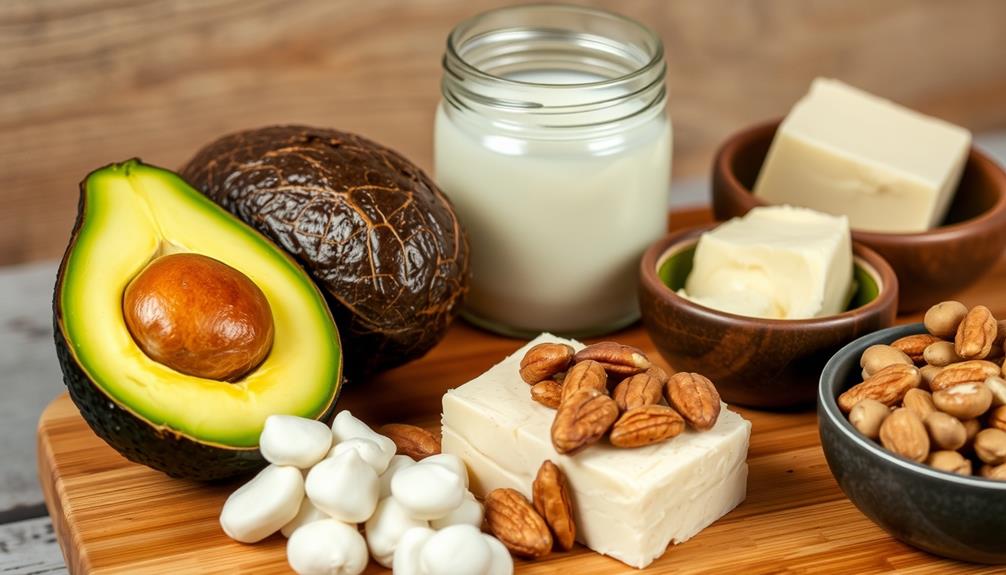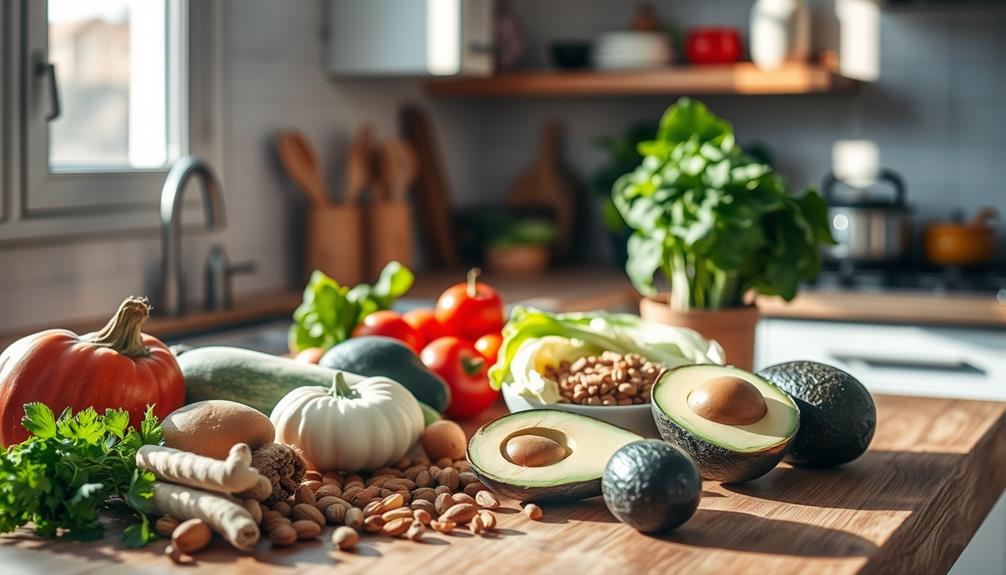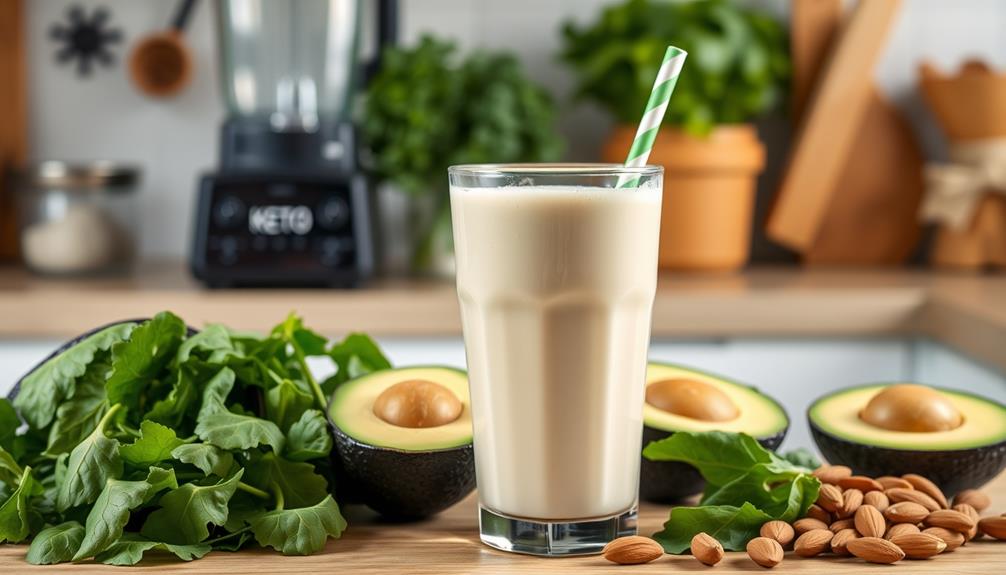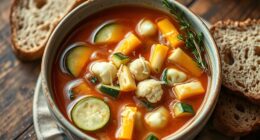The best fats for a keto diet help you stay in ketosis while boosting your health. Focus on healthy sources like avocados, olive oil, and fatty fish. These unsaturated fats improve heart health and reduce inflammation. Incorporate nuts, chia seeds, and nut butters for their beneficial nutrients. Aim for a balanced omega-6 to omega-3 ratio for ideal well-being. While enjoying these healthy fats, watch your portion sizes, especially with saturated fats. By making smart choices, you support your body and enhance your keto experience. Discover more about how each fat source can impact your journey to health.
Key Takeaways
- Healthy fats should make up 60-80% of daily caloric intake on a keto diet for effective ketosis.
- Top fat sources include avocados, olive oil, fatty fish, nuts, and chia seeds, rich in essential nutrients.
- Unsaturated fats improve heart health, while omega-3 fatty acids lower triglycerides and enhance brain function.
- Limit trans fats and excessive saturated fats to reduce heart disease risk and maintain cholesterol levels.
- Gradually incorporate healthy fats into your meals, monitoring portion sizes for optimal health benefits.
Understanding Healthy Fats

Healthy fats play an essential role in the keto diet, making up 60-80% of your daily caloric intake. Focusing on unsaturated fats is vital for improving your heart health and reducing mortality rates.
You'll find numerous sources of healthy fats that can easily fit into your meals, such as avocados, olive oil, nuts, seeds, and fatty fish. These foods not only taste great but also provide beneficial nutrients that support your overall well-being.
Additionally, incorporating foods rich in antioxidants and vitamins, like celery juice, can further enhance your health while on the keto diet.
Incorporating MCT oil into your diet can be especially beneficial, as it boosts energy levels and enhances ketone production, helping you shift into ketosis and promote fat burning.
To optimize your health, aim for an ideal omega-6 to omega-3 fatty acid ratio of 4:1 or lower. This makes it important to include omega-3-rich foods like flaxseeds and fatty fish in your meals.
While you focus on healthy fats, be sure to limit unhealthy fats, particularly trans fats found in processed foods. This is significant for maintaining heart health and achieving successful outcomes on your ketogenic diet.
Emphasizing healthy fats will set you up for greater success on your keto journey.
Top Healthy Fat Sources

Incorporating the right fat sources is essential for maximizing the benefits of your keto diet. Here are some top healthy fat sources to evaluate:
| Fat Source | Benefits |
|---|---|
| Avocados | 10.5g of fat, 1g net carbs; rich in monounsaturated fats and fiber, promoting heart health. |
| Olive Oil | 13.5g of fat, only 2g saturated fat per tablespoon; linked to improved cholesterol levels and antioxidant benefits. |
| Fatty Fish | About 22g of fat; high in omega-3 fatty acids, supporting heart health and providing quality protein. |
| Nuts & Nut Butters | Almond butter has 8.9g of fat, 1.5g net carbs per tablespoon; versatile and nutritious fat sources. |
| Chia Seeds | 8.7g of fat, 2.1g net carbs per ounce; rich in omega-3s, beneficial for overall health. |
| Flaxseeds | Similar benefits to chia seeds; great for improving the omega-6 to omega-3 ratio. |
How to Incorporate Fats

To effectively incorporate fats into your diet, start by gradually adding healthy sources to your meals, such as avocado or olive oil, which are rich in monounsaturated fats.
Experiment with recipes that highlight fats while paying attention to portion sizes to maintain your daily goals.
Incorporating essential oils for wellness can also enhance your culinary experience.
With a little creativity, you can easily make delicious dishes that keep you in ketosis.
Gradual Fat Integration
Changing to a higher fat intake can feel intimidating, but with a gradual approach, it becomes manageable and enjoyable. Start by replacing your cooking oils with healthier options like olive oil or avocado oil, which offer heart-healthy monounsaturated fats. This simple switch helps ease you into a higher fat intake without overwhelming your taste buds.
Incorporating balanced diet principles into your meal planning can also facilitate this shift.
Next, gradually add healthy fats to your meals. Incorporate avocado slices into your salads or use nut butters in smoothies to boost fat content. Experiment with one high-fat food at a time, such as fatty fish or full-fat dairy, to find what you enjoy and can easily integrate into your diet.
Use healthy fats as flavor enhancers; drizzle extra virgin olive oil over vegetables or meats to elevate both taste and fat content.
Remember to monitor portion sizes, as these fats are calorie-dense. Start by adding 1-2 tablespoons of your chosen fat source per meal, adjusting as needed based on your energy requirements and dietary goals.
This gradual fat integration will help you feel more comfortable and satisfied with your new eating style.
Recipes and Meal Ideas
Many people find it easy to enjoy a variety of delicious recipes that incorporate healthy fats into their meals. Start your day with a tasty avocado toast by spreading mashed avocado on low-carb bread, giving you 10.5g of fat and just 1g of net carbs per half avocado.
For a nutritious snack, try chia seed pudding—mix chia seeds with coconut milk and let it sit overnight for a delightful treat packed with 8.7g of fat and only 2.1g of net carbs per ounce. Understanding the balance of healthy fats can enhance your overall well-being, similar to how various brewing methods affect caffeine content in coffee.
When it comes to lunch or dinner, create fatty fish tacos using grilled salmon or sardines wrapped in lettuce leaves, topped with creamy avocado for a healthy dose of omega-3 fatty acids.
If you're in the mood for a smoothie, blend almond or peanut butter with unsweetened almond milk and spinach, which can provide up to 8.9g of fat per tablespoon.
Portion Control Strategies
Incorporating healthy fats into your keto diet is rewarding, but managing portion sizes is key to staying on track. Start by gradually increasing your fat intake with sources like olive oil, avocado, and nuts, while also considering your overall budget for food expenses. This smooth adjustment helps your body adjust without feeling overwhelmed.
Utilize measuring tools like tablespoons and food scales for accurate portion control, especially with calorie-dense items like nut butter and oils.
When snacking, opt for high-fat options like cheese or fatty cuts of meat to satisfy hunger while keeping your overall fat consumption balanced. Be mindful of serving sizes; for example, just 1 oz of almonds contains about 14g of fat, which can quickly impact your caloric goals.
Don't forget to incorporate fat bombs or high-fat recipes into your meals. These can be delicious additions, but make sure to track their ingredients and portions to stay aligned with your macronutrient goals.
Fats to Limit

When following a keto diet, you'll want to limit certain fats for better health.
Trans fats, often found in processed foods, can increase your risk of heart disease, while high saturated fats from foods like fatty cuts of meat may elevate your LDL cholesterol levels.
Being mindful of these fats can help you achieve your health goals more effectively.
Saturated Fat Sources
Moderation is key when it comes to saturated fat sources on a keto diet. Foods like butter, cream, and fatty cuts of red meat are high in saturated fat, which can impact your heart health and cholesterol levels.
While some studies suggest that moderate consumption may not greatly increase heart disease risk, it's essential to prioritize unsaturated fats for overall well-being.
The American Heart Association recommends limiting saturated fat to less than 10% of your total daily calories. This balance helps to manage your cholesterol levels and reduce the risk of cardiovascular disease.
For instance, heavy cream contains about 3.5 grams of saturated fat per tablespoon, and coconut oil has around 9.6 grams. This highlights the importance of portion control when including these fats in your diet.
Trans Fats Risks
Trans fats can sneak into your diet through processed foods and fried items, posing considerable risks to your heart health. These harmful fats raise LDL cholesterol levels while lowering HDL cholesterol levels, greatly increasing your risk of heart disease.
The World Health Organization (WHO) recommends eliminating industrially produced trans fats entirely due to their severe health impacts. Although the U.S. Food and Drug Administration (FDA) banned artificial trans fats in 2018, some exceptions existed until 2021, showing how seriously these health risks are taken.
Even small amounts of trans fats can harm your cardiovascular health, so it's important to read food labels and avoid products containing hydrogenated oils.
When following a ketogenic diet, prioritizing healthy fats is essential, and steering clear of trans fats is a critical part of that. By limiting these unhealthy fats, you not only support your heart health but also improve your chances of sticking to your keto lifestyle.
Stay vigilant and choose whole, unprocessed foods to guarantee you're fueling your body with the right fats.
Health Benefits of Fats
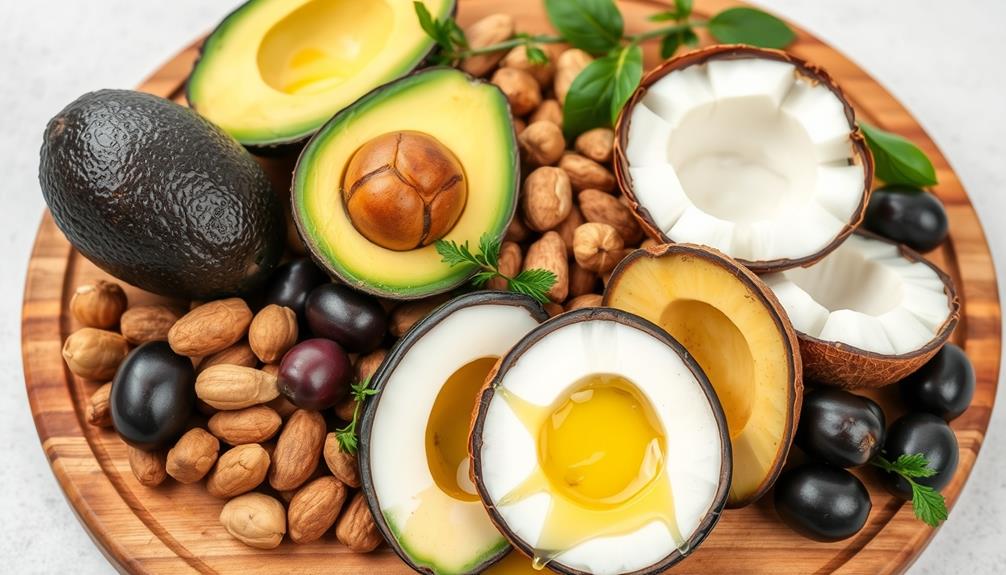
While some people still shy away from fats, incorporating healthy fats into your diet offers numerous health benefits that can enhance your overall well-being.
Healthy fats, like those found in avocados, nuts, and fatty fish, provide essential fatty acids that support heart health and reduce inflammation. By adding monounsaturated fats, such as olive oil and avocado oil, you can improve your cholesterol levels and decrease the risk of cardiovascular disease.
Omega-3 fatty acids, abundant in fatty fish and flaxseeds, are particularly beneficial. They lower triglycerides and support brain health, potentially reducing the risk of cognitive decline.
Additionally, consuming healthy fats aids in the absorption of fat-soluble vitamins (A, D, E, K), which are essential for overall health and immune function.
A balanced intake of healthy fats also plays a role in blood sugar regulation and promotes satiety, which can assist in weight management while following a ketogenic diet.
So, don't shy away from these critical nutrients; embracing healthy fats can markedly contribute to your long-term health and vitality.
Make these fats a regular part of your meals for a healthier lifestyle.
Monitoring Cholesterol Levels
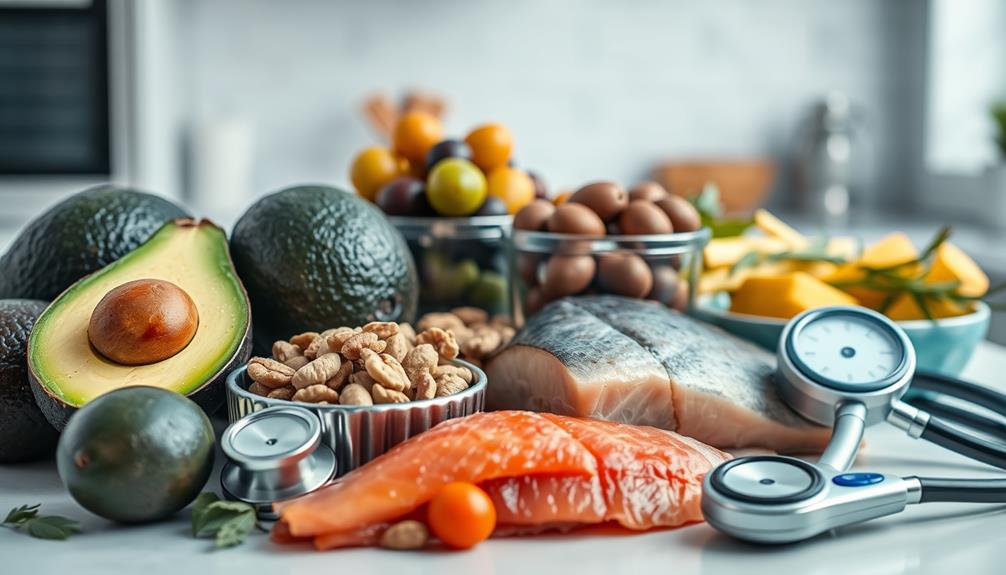
Incorporating healthy fats into your diet can greatly impact your cholesterol levels, making it important to monitor them regularly, especially if you're following a ketogenic diet.
While many individuals experience lower cholesterol levels over time, responses to dietary fats can vary. This means you need to pay close attention to how your body reacts.
Focusing on unsaturated fats from sources like avocados, nuts, and fatty fish can support your heart health while maintaining a balanced intake of healthy fats.
However, excessive consumption of saturated fats can increase LDL cholesterol levels, so moderation is key. Regular cholesterol screenings are vital, particularly when starting a high-fat diet, as they help track changes in LDL and HDL cholesterol levels and assess your cardiovascular risk.
If you have a history of cholesterol-related health issues, consider consulting healthcare professionals for personalized advice on managing your cholesterol and dietary fat intake.
This approach guarantees you're taking the right steps to maintain ideal cholesterol levels while enjoying the benefits of the keto diet.
Practical Tips for Success
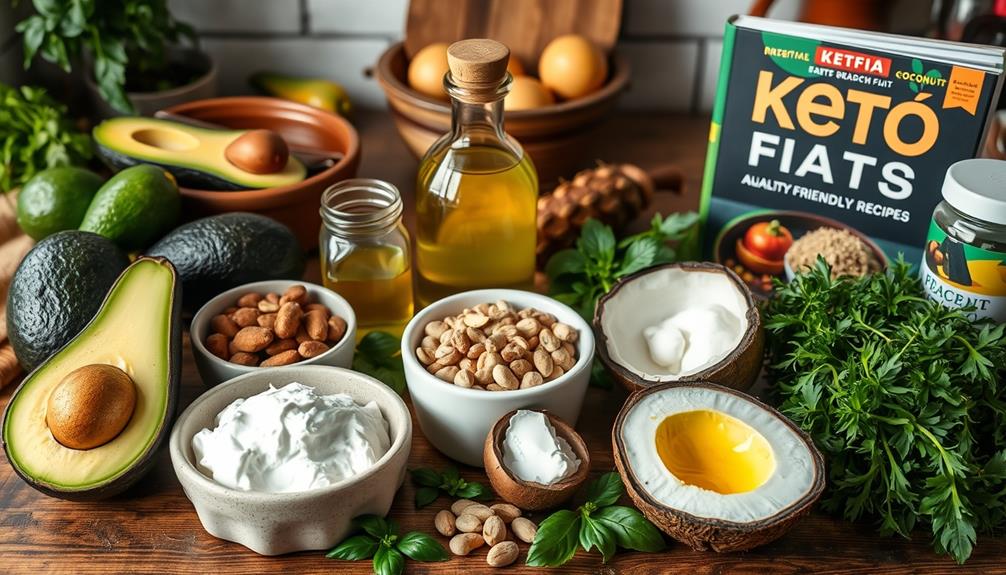
To thrive on the keto diet, it's essential to integrate healthy fats seamlessly into your daily meals. Aim for a daily fat intake of 70-80% of your total calories to effectively support ketosis. Start by gradually introducing versatile fat sources like olive oil, avocado oil, and fatty fish. These not only help you meet your dietary goals but also enhance your heart health.
Incorporate high-fat dressings and dips made from avocados or nut butters to boost the fat content of your low-carb vegetables and snacks. Remember, fats are calorie-dense, so monitor your portion sizes carefully. For instance, half an avocado packs around 114 calories and 10.5 grams of fat.
Experiment with recipes that feature healthy fats, such as fat bombs or creamy sauces, to discover enjoyable ways to maintain your fat intake on the keto diet. These strategies will help you stay on track while making your meals delicious and satisfying.
Frequently Asked Questions
What Kind of Fat Is Best for Keto?
When choosing fats, focus on unsaturated options like olive oil and avocados. Incorporate omega-3s from fatty fish and consider coconut oil for quick energy. Nuts and seeds also provide healthy fats and essential nutrients.
What Are Bad Fats to Avoid on Keto?
You should avoid trans fats found in processed foods, limit processed meats and fried foods, steer clear of high-saturated fats, and bypass unhealthy oils like soybean and corn to maintain a healthy diet.
What Are the Best Fatty Meats for Keto?
If you think all meats are created equal, think again! Ribeye, pork belly, and chicken thighs are your best buddies on keto. They'll keep your fat levels high and your taste buds singing. Enjoy!
What Happens if You Don't Eat Enough Fat on Keto?
If you don't eat enough fat on keto, you'll likely feel fatigued, crave carbs, and struggle to maintain ketosis. You might also experience nutrient deficiencies and symptoms like irritability or brain fog.
Conclusion
You might think that eating fats will sabotage your health, but that's a common misconception. Embracing healthy fats on a keto diet can actually boost your energy and support weight loss. By choosing the right fats and incorporating them wisely into your meals, you'll fuel your body while enjoying delicious flavors. Remember, it's all about balance and making informed choices. So go ahead, savor those healthy fats, and watch how they transform your diet!
